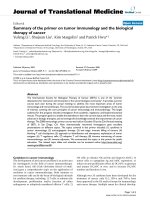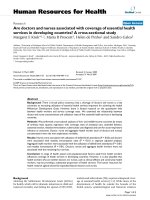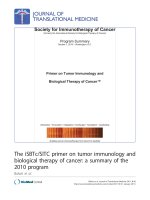Biological importance of essential oils
Bạn đang xem bản rút gọn của tài liệu. Xem và tải ngay bản đầy đủ của tài liệu tại đây (1.81 MB, 15 trang )
We are IntechOpen,
the world’s leading publisher of
Open Access books
Built by scientists, for scientists
4,500
118,000
130M
Open access books available
International authors and editors
Downloads
Our authors are among the
154
TOP 1%
12.2%
Countries delivered to
most cited scientists
Contributors from top 500 universities
Selection of our books indexed in the Book Citation Index
in Web of Science™ Core Collection (BKCI)
Interested in publishing with us?
Contact
Numbers displayed above are based on latest data collected.
For more information visit www.intechopen.com
Chapter
Biological Importance of Essential
Oils
Muhammad Irshad, Muhammad Ali Subhani,
Saqib Ali and Amjad Hussain
Abstract
Essential oils are the volatile compounds having the oily fragrance. Essential oils
are obtained from the different plant parts, and they are extracted from the different
techniques and the most preferable method of extraction is the hydrodistillation which
is cheap and easy to use. Plant parts including the flowers, leaves, stem, bark and roots
are used for the isolation of essential oils. Essential oils are used in almost every field of
life and because of these characteristics, the market of essential oils is growing rapidly.
Essential oils are used in the aromatherapy and act as antioxidant, antimicrobial,
antifungal, pain relievers, anxiety, depression. In the field of cosmetics and industries,
the essential oils are used rapidly and mostly used in the perfume industries which are
growing increasingly. Essential oils are used in the food preservations and many food
items. Essential oils are used as the folk herbal medicines and their fragrance is used for
the improvement of the mood and as the depression release.
Keywords: acts as the antioxidant, antimicrobial, antifungal, pain reliever,
anxiety and depression
1. Introduction
Essential oils have been used in the folk medicines throughout the history.
Essential oils are called the ethereal or volatile oils, which are fragrant oily liquid that
are extracted from the various parts of the plants and mostly used as the food flavors.
An essential oil is “essential” in sense that it contains the essence of the different fragrance, and the properties of the plants from which they are derived. These volatile
oils showed the different kinds of biological activities including the antibacterial,
antioxidant, antiviral, insecticidal, etc. [1]. These oils are also used for cancer treatment, while some other has been used for the food preservations, aromatherapy,
and in the perfumery industries [2]. The antimicrobial and antioxidant screening of
essential oil acts as the root of numerous applications including the processed and
fresh food preservations, natural therapies, pharmaceuticals, and alternative medicines [3]. Essential oils are used in aromatherapy as an alternative source of wound
healing because of the aromatic compounds that are present in the essential oils. It is
also used as a relaxation process, but this evidence is not under consideration [4].
Numerous efforts are made to explore the essential oils usage as the treatment of
various infectious diseases that supernumerary to the pharmaceutical’s remedies.
Medicinal and aromatic plants are extensively used as natural organic compounds
1
Essential Oils - Oils of Nature
and as medicines [5]. Previously, essential oils have been used for the treatment
of various sorts of infectious diseases in the whole world. Now, in this era, the
importance of essential oils is increasing day by day, because they are mostly used
in the beverage and food industries, cosmetics and fragrance industries for making
valuable perfumes, and with lot of biological activities [6].
Various essential oils have been used for the insecticidal activities against the
different pests, but in detail, studies showed that they do not show the repellence, avicidal, phytochemistry, antifungal, and oviposition. The essential oils
do not show the abovementioned characteristics, but there is still urgent need
to work on this side of research and study the in vivo and in vitro studies to
control the pests, and most of the oils have shown good antioxidant activities [7].
Essential oils that showed good antioxidant activates and acts as the defensive
role for the unsaturation of lipids in the tissue of the animal and they also act as
hepatoprotective negotiators in mammals. The antioxidant substances are most
important for human being because of the oxygen which is a toxic element and
has the ability to change the metabolic activities into the most reactive form of
oxygen just like the super oxide, hydrogen peroxide, hydroxyl free radicals, and
the singlet oxygen which are collectively called as active oxygen [8]. Essential
oils are best known for their action as the antispasmodic, antiviral negotiators,
antimicrobial, and carminative, and the essential oil composition is variable;
they also show different sorts of activities and mostly depend upon the chemo
types [9].
2. Sources and isolation of essential oils
Essential oils were extracted from different aromatic plants. These plants
are distributed in the tropical countries and Mediterranean. These plants got
importance because local people use them for the treatment of diseases. The
essential oil is produced in every part of the plant including the leaves, seeds,
buds, stem, flowers, leaves etc as shown in Figure 1. Essential oil is accumulated
from the epidermic cell, cavities, secretary cells, and channels [10]. The odor
that is produced in plants is because of essential oils. The essential oils were
extracted from the dried, fresh, or partially dehydrated materials of plant. The
extraction rate depends upon the diffusion via plant tissues that directly involve
the surface from which the essential oil was removed by different processes. The
extraction of essential oil depends upon the stability of the essential oil. The
two most important method that are used for the extraction of essential oil was
used are steam distillation method and the hydro distillation process as shown in
Figure 2. These are the most suitable and effective techniques for the extraction
processes [11]. Some other methods were also used for extraction but they are
not too much suitable for this process these are the microwave or liquid carbon
dioxide, high- or low-pressure distillation with the help hot water or steam water
(Figures 1 and 2) [12].
The essential oil extracted from the steam distillation method is mostly used in
pharmacological activities and food items, while the essential oil that are used in the
fragrance industry or perfume industry are extracted from the lipophilic solvents
and sometime with the supercritical carbon dioxide going more attractive [13]. The
quality of the essential oil depended on the basis of the age of plants, parts that are
used for extraction, vegetative cycle stage, effect of climate, etc. The chromatographic and the spectroscopic techniques fully changed the chemical analysis of
the essential oils. The chemical composition of the essential oils was studied with
the help of IR-spectroscopy, UV-Vis spectroscopy, gas chromatography, NMR
2
Biological Importance of Essential Oils
DOI: />
Figure 1.
Plants and their parts used for the isolation of essential oils.
Figure 2.
Hydrodistillation apparatus used for the extraction of essential oils.
spectroscopy [14]. The enhanced demand for the essential oil in various fields of
life provoked us to access the reliable methods for the essential oil analysis, and the
techniques used are the GC-MS and GC analyses [15]. The characterization of the
essential oil was carried out by using the gas chromatography. The compounds that
are present in the essential oil was confirmed by using the GC and GC-MS analysis
[16]. The storage and handling of the essential oil also affect its yield and quality, ad
essential oil was deposited in the oil glands that are present in the organization of
the plant material [16].
3
Essential Oils - Oils of Nature
3. Essential oil industry
The worldwide essential oil market demand was 226.8 kilotons in year 2018. It is
expected to expand at a CAGR of 8.6% from the 2019 to 2025. Usage of essential oils
in industries are increases day by including the beverage, food, personal care, aromatherapy, and cosmetics. Various sorts of the health-related benefits are offered
by essential oils and they are reported as the anticipated fuel and their demand is
increasing in the medical and pharmaceuticals applications. Most of the conventional drugs have no side effects. The growing inclination of the consumers toward
the organic and natural products is leading to increase the use of essential oils in the
beverage, food, and cosmetics industries. Worldwide essential oil market will cross
USD 13 billion in the year of 2024 the latest report of the Global Market Insights,
Inc. The increase in the World population are suffering from the different kinds of
health-related issues and essential oils are used in aromatherapy products and due
to this reason, the Worldwide market of essential oils are increasing day by day [17].
The period when essential oils were utilized first on a commercial scale is
hard to recognize. The nineteenth century is for the most part viewed as the
beginning of the cutting-edge period of commercial utilization of essential oils.
Notwithstanding, the extensive scale use of essential oils goes back to antiquated
Egypt. In 1480 BC, Queen Hatshepsut of Egypt sent a campaign to the nation of
Punt (presently Somalia) to gather fragrant plants, tars, and oils, as elements for
medicaments, scents, and flavors and for the preservation of bodies. Valuable
scents have been found in numerous Egyptian archeological unearthing, as an
image of riches and social position. The huge global exchange of fundamental
oil-based items is the standard for modern use; “Ruler of Hungary Water” was the
primary alcoholic scent ever. This aroma, in view of rosemary basic oil distillate,
was made in the mid-fourteenth century for the Polish-conceived Queen Elisabeth
of Hungary. Following an uncommon introduction to King Charles V, The Wise of
France in 1350, it ended up prevalent in all medieval European courts. The start
of the eighteenth century saw the presentation of “Eau de Cologne,” in light of
bergamot and different citrus oils, which remains broadly used right up ‘til the
present time. This crisp citrus aroma was the making of Jean Maria Farina, a relative
of Italian perfumers who came to France with Catherine de Medici and settled in
Grasse in the sixteenth century. As indicated by the city of Cologne files, Jean Maria
Farina and Karl Hieronymus Farina, in 1749, built up a processing plant (Fabriek) of
this water, which sounds exceptionally “mechanical.” The “Kolnisch Wasser” turned
into the main unisex aroma as opposed to one basically for men, known and utilized
all over Europe, and it has been rehashed in this manner in incalculable countertypes as a scent for men. The essential oil market was extended day by day because
of increase in demand for the essential oil products including the soap, cosmetics,
and food industries. The international companies are the major contributors of the
development of the essential oil industries in the mid-nineteenth century [18].
Changing the standards of the living led to the occurrence of different sorts of
mental issues including the depression, anxiety, insomnia, and stress that led to grow
the market of essential oils because they are used for the treatment of such kinds of
diseases. There are more than 300 industries in the Pakistan which industrialized
various human resources. These industries used unprocessed material especially
essential oils that are imported from the western countries. Pakistan imports more
than Rs. 1526.8 million to buy essential oils and perfumes and isolates [19]. Pakistan is
an agricultural country that is rich in aromatic sorts of plants, which are used as natural medicines and are used in local areas to cure common diseases. The environment
of Pakistan is much more suitable for the growth of essential oils crops. And from
4
Biological Importance of Essential Oils
DOI: />
these plants the essential oils obtained, and they are used in essential oil industries,
but this industry is not much more attractive in Pakistan.
4. Modern trends of essential oils
The essential oil has been large number of usages in worldwide products including the ice creams perfumes, backed food stuff, beverage, and cosmetics as shown
in Figure 3. Newly, at least 300 kinds of essential oils out of 3000 are commercially
important in various kinds of industries including the perfume and sanitary industries,
cosmetics, food, beverage, agronomics, and pharmaceuticals [20]. Some of the bioactive components that are present in essential oils are the limonene, geranyl acetate, carvone, etc., and these are the important components of the hygienic products and tooth
pastes. Essential oils are used for the preservation of the food additives; for the treatment of common diseases and folk medicines; and used by aromatherapist. Essential
oils are used as the natural antioxidant. The usage of natural antioxidant is prominent
in the defensive medicines and food items, and because of this reason, essential oils are
getting popular day by day. Recently, the growth explores the applications of the volatile
essential oils for remedial usage and in the treatment of some infectious diseases [21].
Essential oils are widely used in perfumes, personal hygiene products, and
in aromatherapy including the inhalation, massage, masking agent to avoid the
unpleasant odor in the textile industries, paint and plastic industries, and pharmaceuticals formulations. Essential oils are also used as the natural antifungal and
antibacterial agents in the food safety items; essential oil also used in the various
kinds of cereals, antimicrobial packing of the food items, edible thin film, nanoemulsion, preservation of the fruits and vegetables, soft drinks, as the flavoring
agents in the carbonated drinks, as the major ingredients in soda/citrus concentrates, seafood preservations, fish, etc. (Figure 3) [22].
Figure 3.
Modern trends of essential oils.
5. Growing trends of essential oils adaptation
The essential oils are the products that are obtained from the plant extracts
and have been used for large-scale industrial and homemade products. The major
usages of essential oils are pest control products, cleaning actions, and counter
5
Essential Oils - Oils of Nature
medications among the other products and personal care products. Essential oils
have various advantages in wound healing, rejuvenation, and relaxation. Alongside
their applications in the betterment of the health issues, the most common health
issues such as migraines and nausea are cured from the essential oils. It is also used
in the food industries because of their preservative potential in contrast to the
foodborne pathogens, antibacterial, antimicrobial, and antifungal characteristics.
The use of aromatherapy as the harmonizing care is speedup due to their unique
characteristics which include the coping with some of side effects of cancer and to
promote the wound healing [23].
6. Uses of essential oils in perfumery
The essential oils that are used in the perfume industries are classified according
to their diffusion rate in air and volatility:
Base note: these are the least volatile essential oils and last for a longtime
period. These remain for longtime duration including several hours. Some essential oils that are used as the base notes are the Myrrh, vanilla, sandalwood, and
frankincense.
Middle note: these sorts of essential oils are tending to be spicy or floral and give
body to blends; their time duration is less and remain up-to 1 hour. These include
Ylang-ylang, jasmine, geranium, clove, and lavender.
Top note: these are the most volatile and the first perceptible odors from the perfume. Their time duration is too much less and remains maximum for 30 minutes.
These include berry, bergamot, cinnamon, juniper, and gardenia.
Perfumes are formulated mostly using alcohol, though these may contain the cloudy
solutions. Eau de types of perfumes are mostly formulated using the essential oils
generally amber color because of their natural oils color but normally they are clear.
6.1 Percentage of essential oils in different perfumes products
• Eau de perfume usually contains 8–15% amount of essential oils or sometimes
their fragrance, and 80–90% alcohol.
• Splash cologens usually contain 1–3% fragrance or essential oil, and 80% alcohol.
• Eau de cologne usually contains 3–5% of fragrance or essential oil, and up to
70% alcohol.
• Eau de toilette usually contains the essential oil between 4 and 8% or its fragrance, and 80–90% alcohol [24].
6.2 Increasing the sales of essential oils to the home appliances
All over the world, people are shifting toward the herbal products for the treatment of skin diseases compared to medicines and synthetic drugs. The essential oil
is pure and does not have any side effects. The demand for essential oil is increasing
because of their usage in daily life and it is mostly used for the relaxation purpose
and people prefer it because of its no side effects. Aura Cacia that is manufacturer of
Iowa-based care products said that the essential oil sale was increased 90% between
the 2009 and 2012, and the sale of household items that contains the essential oil
was increased from 6 to 12%.
6
Biological Importance of Essential Oils
DOI: />
Essential oils play a key role in treating the dermatological issues including the
rashes, acne, hives, eczema, and psoriasis which made the essential oil suitable for the
skin treatment care products that enhance the growth of skin industry. The market of
essential oils is growing because it has no side effects, and other synthetic chemicals
have side effects, so they are less preferred. Essential oils market of home care products
and cleaning products will be increased to 550 million USD by 2024. The growth in
essential oil market along with the companies that are introducing the products with
supplementary benefits such as better cleaning, easy fragrance, and germ fighting.
The essential oils market of France will be increased up to 8.5% by 2024. Major
cosmetics industries used essential oils in cosmetics and imported these oil products
worldwide. Companies used the marketing strategies to spread the awareness to the
people regarding the usage and benefits of essential oils, and the aromatherapy markets
gets more enhanced customers to buy these products. The essential oil market of India
will be exceeding up to 790 million USD by 2024. Since being a large country, India used
the large-scale agricultural techniques to grow crops of essential oil plants including
lemon, mint, and spices, and its aromatherapy market are growing day by day.
Lavender oil market will be reached up to 20 kilotons by 2024. It is used in
fighting the serious health conditions, including the chronic anxiety, relieves
pain, cancer, stress with reverse sign of the ageing, headache, cosmetics applications, pharmaceuticals applications, aromatherapy etc. as shown in (Figure 4).
The major companies that share large market size of essential oil-based products
are Firmenich, Frutarom, Flaex, Rock Mountain Moksha Lifestyle, and Florihana
Falcon Young living (Figure 4) [25].
6.3 Some major essential oils and their applications
6.3.1 Bergamot
The essential oil of bergamot obtained from the peel of the fruits of the Citrus bergamia is known as the bitter orange tree. The extract of the bergamot is used in flavoring
Figure 4.
Applications of essential oils in daily life.
7
Essential Oils - Oils of Nature
in Earl Grey tea and essential oil of this is used also for the same purpose. It is applicable
for the treatment of skin diseases, and it improves the mood, relieves pain, reduces
fever, treats the digestive system problems, and breaks up chest congestion [26].
6.3.2 Clove
It is extracted from the aromatic flower buds of Syzygium aromaticum tree that is
native to Maluku, Indonesia. The essential oil of Clove provides the strong fragrance, used in cooking spice foods; medically, it is used as pain relief, used for the
treatment of dental disorders, for nausea treatment, to reduce inflammation, for the
treatment of the digestive ailment, and to clear up acne [26].
6.3.3 Eucalyptus
It is extracted from the different species of genus Eucalyptus. Every type of species
contains different and unique usage in every field. The most familiar essential oil
obtained from the Eucalyptus globulus has a mint-like fragrance. It is used for decongestant chest rub, as pain relievers, as an antimicrobial agent, immunostimulant, and
for the treatment of the flu and cold cough. It is used in aromatherapy and it provides
mental clarity; it also boosts up energy and used as a natural insect repellent [26].
6.3.4 Frankincense
The earliest known and the most useful essential oil is Frankincense and it
is obtained from the resin of the four species of the generous Bowwellia and the
most known from this genus is the Bowsellia carterii hard tree which grow in the
arid land of Arabian Peninsula and north eastern. The old African people used
the essential oil of Frankincense in the religious and spiritual ceremonies. The
Frankincense essential oil is unique from all other obtained essential oils because of
the perfect combination of wood, balsam, earth, and citrus. It is used as the mood
enhancer, antimicrobial, stress reducer, for faster wound healing, aid in digestion,
anti-inflammatory, fades scars, reduces swelling of insect bites, for the treatment of
skin diseases, and eases itching [26].
6.3.5 Lavender
The most effective essential oil obtained from the Lavandula angustifolia is the most
popular garden herb English lavender. Its odor is same as the flowers from which they are
obtained having the sweet smell, floral, and green, and the health benefits are greater
as compared to their fragrance. The best purpose of essential oil of lavender is their
sleep-inducing properties and calmness. It showed good antioxidant, anti-inflammatory,
antibacterial, and antifungal properties, and it is also used for the treatment of various
sorts of skin diseases including eczema or ringworm and acne. Lavender essential oil
is used to enhance the digestive system, to reduce the swelling of sore muscles, and to
relieve pain. Due to its attractive smell, it attracts butterflies, bees, and some pollinators,
and it also acts as a natural repellent for many flying six-legged pests [26].
6.3.6 Lemon
Essential oils obtained from the lemon are mostly used. The essential oil obtained
from the Citrus limon is used worldwide. The essential oil of lemon is used as antimicrobial agents, in household items including soaps, polishes, furniture, fresheners, and
8
Biological Importance of Essential Oils
DOI: />
in most of the cleaning products. Some other uses of these essential oils are that they
are the pain relievers, show antifungal activity, help for the loss of weight, and alleviate the severe nausea; the essential oil of lemon is used in aromatherapy to reduce the
anxiety and stress and simultaneously enhances the concentration and mood. It is also
used for cleaning the hair and enhancing the natural growth of hairs [26].
6.3.7 Oregano
The essential oil of Oregano was obtained from the kitchen spice Origanum vulgare. It is the perfect combination of the earth, spice, and warmth. When the bottle
of essential oil is opened, their fragrance has an effect on the senses. The usage of
the essential oil of Oregano is increasing day by day and it is mostly used for the
skin care treatment like eczema, rosacea, and psoriasis. It is used to alleviate the
menstrual problems or painful menstrual cramp, used to cure stomach problems,
and helps to control the flu and cold infections [26].
6.3.8 Peppermint
The essential oil of peppermint is used worldwide and it is obtained from the
Mentha piperita. This mint hybrid is the most favorite between the essential oil and
gardeners. It is the most famous type of essential oil because of its unique applications, and it is mostly used in preventing flu and cold, alleviating headache, relieving pain in muscles and joints, clearing the skin conditions, relieving nausea, and
improving the digestive system processes [26].
6.3.9 Rosemary
The essential oil of rosemary is obtained from the evergreen shrub of Rosmarinus
officinalis and is famous albeit common kitchen herb has the extraordinary healing
potential in its natural oil. Just like the rosemary, the essential oil of this herb has
the crisp woody, herbal, and somewhat balsamic odor just like the camphor. Due to
its unique fragrance of rosemary oil, it is used for cleaning the inside and outside of
the body. It is further used for the treatment of various diseases, especially skin care,
dandruff treatment, to improve the scalp health, to boost up the immune system, flu
infections, and ward off cold. Although this oil is used to alleviate the pain, swelling
in joints and muscles, for treatment of the digestive tissues, soothe tension headaches, to promote the mental clarity, to enhance the memory, and improve mood, it
is also the best natural insecticide and the bug repellent [26].
6.3.10 Tea tree
The essential oil of the tea tree is obtained from the leaves and stem of Melaleuca
alternifolia and shrub of Camellia sinensis. The oil is toxic if ingested directly and it is
used mostly for the external purposes and has the herbal, fresh, and slightly camphorates aroma. Melaleuca claims that essential oil of tea tree act as an antimicrobial
agent, treating antifungal infections, and cleansing wounds. It is used in cosmetics
products including the shampoo to clear some scalp conditions and dandruff and
used for the treatment of insect bite to reduce itching and inflammation [26].
6.3.11 Some plant species essential oils and their usage
Some plant species essential oils and their usage are shown in Table 1.
9
Essential Oils - Oils of Nature
10
S. no.
Plant species
Essential oil
Uses
1
Pimenta racemosa
Bay oil
Aches, muscle circulation, improve dandruff [27]
2
Callitris
intratropica
Blue cypress
oil
Asthma [27]
3
Daucus carota
Carrot seed oil
Detoxification, eczema [27]
4
Apium graveolens
Celery seed oil
Treat of gout, antifungal diuretic, blood pressure,
antiseptic reduces sedative, urinary antirheumatic
[27]
5
Stellaria species
Chickweed
infusion
Wound healing, antirheumatic, astringent [27]
6
Cinnamon species
Cinnamon oil
Antifungal, uterine stimulant, antibacterial [27]
7
Artemisia pallens
Davana oil
Coughs, including menstruation, anxiety, healing of
wounds, antiseptic [27]
8
Canarium
luzonicum
Elemi oil
Coughs, healing wounds, stress [27]
9
Eucalyptus
citriodora
Eucalyptus
citriodora oil
Fever and flu, to improve blood circulation and
sinusitis, arthritis, bronchitis, catarrh, cold stores,
colds and coughs [27]
10
Eucalyptus globulus
Eucalyptus oil
Antiseptic, antispasmodic, treatment of scarlet fever,
influenza, measles and typhoid, infusion reduces
blood sugar levels [27]
11
Alpinia galanga
Galanga oil
Aphrodisiac, easing heart pain and angina, dizziness
and fatigue.
Stomach, spleen, relief of pain, treatment of flu and
colds, travel sickness [27]
12
Pelargonium
graveolens
Geranium oil
Acne, cellulites, lice treatment, menopause [27]
13
Zingiber officinalis
Ginger oil
Promotes sweating, expectorant, prevents
vomiting, antiseptic, anti-spasmodic, carminative,
antibacterial, circulatory stimulant, nausea, relaxes
peripheral blood vessels, promotes sweating [27]
14
Hyssopus officinalis
Hyssop oil
Nervous exhaustion, anxiety, used topically as an
anti-inflammatory, bruises and anti-viral, increases
alertness, uplifting and relaxing nerves [27]
15
Ammi visnaga
Khella oil
Antiasthmatic, diuretic, antispasmodic, relaxant [27]
16
Citrus Limon
Lemon oil
Blemishes, varicose veins, warts, chilibains, colds,
corns, flu, skin, athletes foot [27]
17
Backhousia
citriodora
Lemon myrtle
oil
Insect repellent, stress, athletes foot, colds, flu, skin
blemishes [27]
18
Citrus reticulata
Mandarin oil
Blemishes, stress and wrinkles, acne, insomnia, scars,
skin [27]
19
Mentha species
Mint oil
Analgesic, calming, cooling for migraines, antibacterial, clear nasal congestion, prevents vomiting,
relaxes peripheral blood vessels, promotes bile flow
[27]
20
Myrtus communis
Myrtle oil
Sore throat, asthma, coughs [27]
21
Piper nigrum and
other species
Pepper oil
Aches and pains, coughs, chills, cramps, digestion,
antiseptic, anti-bacterial, topical use increases blood
flow around area [27]
22
Zingiber
cassumunar
Plai oil
Uterine relaxant, inflammatory [27]
Biological Importance of Essential Oils
DOI: />S. no.
Plant species
Essential oil
Uses
23
Rosa species
Rose oil
Astringent, sedative, digestive stimulant, increase
bile production, expectorant, anti-bacterial,
antiseptic, kidney tonic, blood tonic, antidepressant, anti-spasmodic, aphrodisiac [27]
24
Mentha spicata
Spearmint oil
Flu and fever, nausea, vertigo, asthma, exhaustion
[27]
25
Citrus sinensis
Sweet orange
oil
Constipation, cough relief, flu, gum treatment, calms
nerves, digestive stimulant, aids energy
26
Tagetes glandulifera
and patula
Tagetes oil
Warts and corns [27]
27
Vetiveria zizanoides
Vetivert oil
Insomnia, muscle aches, sores and stress, acne, cuts,
anti-depressant, exhaustion [27]
28
Viola odorata
Violet leaf
absolute
Poor blood circulation, sore throat, bronchitis, head
ache, insomnia, rheumatism [27]
29
Melaleuca
alternifolia
Tea tree oil
Fungal, antiseptic, anti-viral, candida, cold sores,
corns, cuts, flu, anti-bacterial [27]
30
Cananga odorata
Ylang oil
Hypertension, palpitations, stress, anxiety, antidepression, frigidity, hypertension [27]
31
Zanthoxylum
alatum
Leaf, stem,
root oil
Antioxidant, antifungal, antibacterial [28]
32
Skimmea laureola
Leaf oil
Antioxidant, antifungal, antibacterial and perfumery
[29]
33
Angelica glauca
Root oil
Antioxidant, antifungal, antibacterial, and
phytotoxicity [30]
34
Thymus serpyllum
Whole plant
oil
Antioxidant, antifungal, antibacterial, and
phytotoxicity [31]
35
Plectranthus rugosus
Leaf oil
Antifungal, antioxidant, antibacterial [32]
Table 1.
Some plant species essential oils and their uses.
7. Conclusion
Essential oils are the natural volatile compounds having loveable odor. The
essential oils are isolated mostly from the hydrodistillation method which is more
suitable for this process and easy to carry. Whole parts of the plants are used for the
extraction of plants. Steam distillation method is expensive than the hydrodistillation, so it is less preferred. Essential oils have good medicinal applications and used
in the treatment of different diseases including the infectious diseases, depression,
anxiety, act as the antifungal, antimicrobial, anticancer, and wound healing; they
are also used in cosmetics and perfume industries. In the field of heath, essential
oils are used more frequently and are mostly applied to the external body parts
to relieve the pain. In the field of fragrance, essential oils are used in the perfume
industry and due to attractive odor, the essential oils are used mostly in this industry. It is used worldwide and due to their better usage, the world essential oil market
is growing rapidly and getting more importance day by day.
Acknowledgements
The author wishes to thank University of Kotli for providing the facilities to
write this chapter.
11
Essential Oils - Oils of Nature
Conflict of interest
Author has no conflict of interest.
Author details
Muhammad Irshad1*, Muhammad Ali Subhani1, Saqib Ali1 and Amjad Hussain2
1 Department of Chemistry, University of Kotli Azad Jammu and Kashmir, Pakistan
2 Department of Zoology, University of Kotli Azad Jammu and Kashmir, Pakistan
*Address all correspondence to:
© 2019 The Author(s). Licensee IntechOpen. This chapter is distributed under the terms
of the Creative Commons Attribution License ( />by/3.0), which permits unrestricted use, distribution, and reproduction in any medium,
provided the original work is properly cited.
12
Biological Importance of Essential Oils
DOI: />
References
[1] Abu-Shanab B, Adwan GM, Abu-
Safiya D, Jarrar N, Adwan K.
Antibacterial activities of some plant
extracts utilized in popular medicine in
Palestine. Turkish Journal of Biology.
2005;28(2-4):99-102
[2] Kelen M, Tepe B. Chemical
composition, antioxidant and
antimicrobial properties of the essential
oils of three salvia species from
Turkish flora. Bioresource Technology.
2008;99(10):4096-4104
[3] Celiktas OY, Kocabas EH, Bedir E,
Sukan FV, Ozek T, Baser KH.
Antimicrobial activities of methanol
extracts and essential oils of Rosmarinus
officinalis, depending on location and
seasonal variations. Food Chemistry.
2007;100(2):553-559
[4] Lee MS, Choi J, Posadzki P, Ernst E.
Aromatherapy for health care: An
overview of systematic reviews.
Maturitas. 2012;71(3):257-260
[5] Tepe B, Daferera D, Tepe AS, Polissiou
M, Sokmen A. Antioxidant activity of
the essential oil and various extracts of
Nepeta flavida hub-Mor. from Turkey.
Food Chemistry. 2007;103(4):1358-1364
Antimicrobial and antioxidant activities
of three Mentha species essential oils.
Planta Medica. 2003;69(05):413-419
[10] Gilani AH, Khan AU, Jabeen Q ,
Subhan F, Ghafar R. Antispasmodic
and blood pressure lowering effects
of Valeriana wallichii are mediated
through K+ channel activation.
Journal of Ethnopharmacology.
2005;100(3):347-352
[11] Kulisic T, Radonic A, Katalinic
V, Milos M. Use of different methods
for testing antioxidative activity of
oregano essential oil. Food Chemistry.
2004;85(4):633-640
[12] Bousbia N, Vian MA, Ferhat MA,
Petitcolas E, Meklati BY, Chemat F.
Comparison of two isolation methods
for essential oil from rosemary leaves:
Hydrodistillation and microwave
hydrodiffusion and gravity. Food
Chemistry. 2009;114(1):355-362
[13] Donelian A, Carlson LH, Lopes TJ,
Machado RA. Comparison of
extraction of patchouli (Pogostemon
cablin) essential oil with supercritical
CO2 and by steam distillation. The
Journal of Supercritical Fluids.
2009;48(1):15-20
[6] Rios JL, Recio MC. Medicinal plants
and antimicrobial activity. Journal of
Ethnopharmacology. 2005;100(1-2):80-84
[7] Dorman HJ, Deans SG. Antimicrobial
agents from plants: Antibacterial
activity of plant volatile oils.
Journal of Applied Microbiology.
2000;88(2):308-316
[8] Pérez Gutiérrez RO, Hernández Luna
H, Hernández Garrido S. Antioxidant
activity of Tagetes erecta essential oil.
Journal of the Chilean Chemical Society.
2006;51(2):883-886
[9] Mimica-Dukić N, Božin B,
Soković M, Mihajlović B, Matavulj M.
13
[14] Hussain AI, Anwar F, Sherazi ST,
Przybylski R. Chemical composition,
antioxidant and antimicrobial activities
of basil (Ocimum basilicum) essential
oils depends on seasonal variations.
Food Chemistry. 2008;108(3):986-995
[15] Daferera DJ, Ziogas BN, Polissiou
MG. The effectiveness of plant
essential oils on the growth of Botrytis
cinerea, Fusarium sp. and Clavibacter
michiganensis subsp. michiganensis.
Crop Protection. 2003;22(1):39-44
[16] Van Vuuren SF, Viljoen AM, Őzek
T, Demirci B, Başer KH. Seasonal and
geographical variation of Heteropyxis
Essential Oils - Oils of Nature
natalensis essential oil and the effect
thereof on the antimicrobial activity.
South African Journal of Botany.
2007;73(3):441 8
/>aromatherapy-market-trend-2019increasing-sales-of-essential-oils-forhome-usage/
[17] Grand Review Research Inc. US.
[26] Taylor J. The 10 Most Popular
Available from: https://www.
grandviewresearch.com/
Essential Oils and 174 Magical Ways to
Use Them. 2016. Available from: https://
www.naturallivingideas.com/author/
jan/ [Accessed: April 12, 2016]
[18] Market Research Reports,
Consulting: Global Market Insights Inc.
[Internet]. Available from: https://www.
gminsights.com
[19] Pakistan Statistical Year Book.
Government of Pakistan, Statistical
Division, Federal Bureau of Statistical;
2008
[27] Murry H. Essential Oils: Art,
Agriculture, Science, Industry and
Entrepreneurship (A Focus on The AsiaPacific Region). Nova; 2009. pp. 626-633
[28] Irshad M, Aziz S, Ahmed MN, Asghar
antibacterial properties and potential
applications in foods—A review.
International Journal of Food
Microbiology. 2004;94(3):223-253
G, Akram M, Shahid M. Comparisons
of chemical and biological studies of
essential oils of stem, leaves and seeds of
Zanthoxylum alatum Roxb growing wild
in the state of Azad Jammu and Kashmir,
Pakistan. Records of Natural Products.
2018;12(6):638
[21] Hajhashemi V, Ghannadi A, Sharif B.
[29] Irshad M, Aziz S, Shahid M, Ahmed
Anti-inflammatory and analgesic
properties of the leaf extracts and essential
oil of Lavandula angustifolia mill. Journal
of Ethnopharmacology. 2003;89(1):67-71
MN, Minhas FA, Sherazi T. Antioxidant
and antimicrobial activities of essential
oil of Skimmea laureola growing wild
in the state of Jammu and Kashmir.
Journal of Medicinal Plant Research.
2012;6(9):1680-1684
[20] Burt S. Essential oils: Their
[22] Mahato N, Sharma K, Koteswararao
R, Sinha M, Baral E, Cho MH. Citrus
essential oils: Extraction, authentication
and application in food preservation.
Critical Reviews in Food Science and
Nutrition. 2019;59(4):611-625
[30] Irshad M, Shahid M, Aziz S, Ghous
T. Antioxidant, antimicrobial and
phytotoxic activities of essential oil
of Angelica glauca. Asian Journal of
Chemistry. 2011;23(5):1947
[23] Aromatherapy Market Trend
2019: Increasing Sales of Essential
Oils for Home Usage. 2019. Available
from: />[Accessed: April 20, 2019]
[24] Use Essential Oils for Perfume to
Improve your Emotional and Physical
Well Being [Internet]. 2015. Available
from: www.experience-essential-oils.
com/essential-oils-for-perfume.html
[25] Aromatherapy Market Trend 2019:
Increasing Sales of Essential Oils for
Home Usage. 2019. Available from:
14
[31] Aziz S, Habib-ur-Rehman, Irshad
M, Asghar SF, Hussain H, Ahmed I.
Phytotoxic and antifungal activities of
essential oils of Thymus serpyllum grown
in the state of Jammu and Kashmir.
Journal of Essential Oil-Bearing Plants.
2010;13(2):224-229
[32] Irshad M, Aziz S, Habib-ur-Rehman,
Hussain H. GC-MS analysis and
antifungal activity of essential oils of
Angelica glauca, Plectranthus rugosus, and
Valeriana wallichii. Journal of Essential
Oil-Bearing Plants. 2012;15(1):15-21









